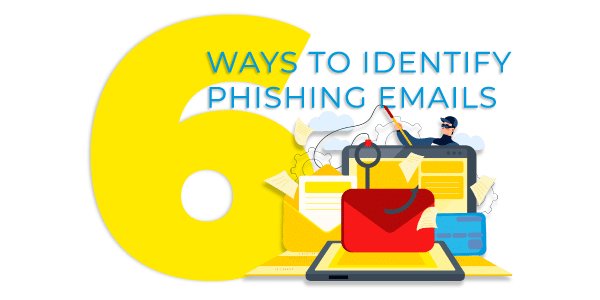Phishing emails are one of the most common types of cyberattacks that people face on a regular basis. These fraudulent emails are designed to look like they are from a legitimate source to trick people into revealing personal information, such as usernames, passwords, and credit card numbers. In this blog post, we will discuss six ways to identify phishing emails and protect yourself from falling victim to these scams.
1. Check the sender’s email address.
One of the easiest ways to identify a phishing email is to check the sender’s email address. Phishing emails often use fake email addresses that are like legitimate ones. For example, an email from “[email protected]” may actually be from “[email protected]” (notice the lowercase “L” instead of the uppercase “I”). By hovering over the sender’s name or email address, you can see if the address matches the legitimate one.
2. Look for spelling and grammar errors.
Phishing emails often contain spelling and grammar errors. This is because scammers may not have English as their first language, or they may be using automated tools to create these emails. If you notice any typos or grammatical errors, this should be a red flag that the email is not legitimate.
3. Beware of urgent or threatening language.
Phishing emails often use urgent or threatening language to pressure you into taking immediate action. For example, an email may claim that your account has been hacked and that you need to change your password immediately. If you receive an email that uses this type of language, take a step back and assess the situation before taking any action.
4. Don’t click on links or download attachments.
Phishing emails often contain links or attachments that lead to malware or fake login pages. If you receive an email that contains a link or attachment, do not click on it. Instead, hover over the link to see where it leads, or download the attachment to a sandbox environment or virus scanner to check for potential threats.
5. Verify requests for personal information.
Phishing emails often ask for personal information, such as your username, password, or credit card number. Legitimate companies will never ask you to provide this information via email. If you receive an email asking for personal information, do not provide it. Instead, go directly to the company’s website and log in to your account to see if there are any legitimate requests for information.
6. Check for generic greetings.
Phishing emails often use generic greetings, such as “Dear Sir/Madam” or “Dear Customer,” instead of addressing you by name. If you receive an email that uses a generic greeting, this should be a red flag that the email is not legitimate. Legitimate emails will typically address you by name.
In conclusion, phishing emails are a common threat to your online security. By following these six tips, you can identify and avoid phishing emails, protecting your personal information and your online security. Remember to always be cautious when opening emails from unfamiliar senders, and to verify any requests for personal information before providing it.
Stay safe online!
